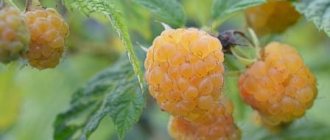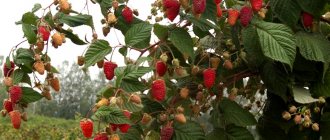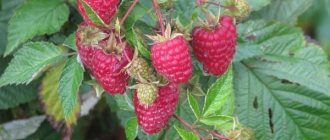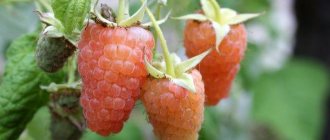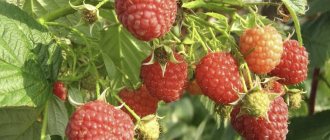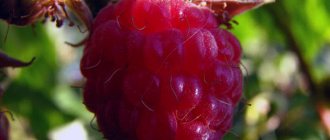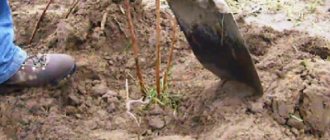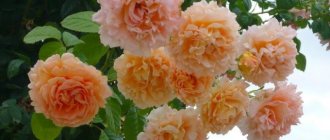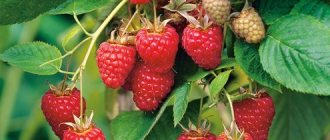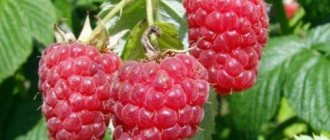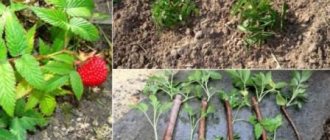Polka raspberries were developed by Polish breeders under the leadership of Jan Daken. The variety was produced for industrial needs. Today, Polka raspberries grow in many European countries and in Russia.
remontant raspberry variety "Polka"
Polka raspberry fruits do not wrinkle or deform during transportation
Fruiting of raspberries of the “Polka” variety lasts three months and ends with the onset of frost
Description of the raspberry variety Polka
This type of raspberry is remontant; it bears fruit until frost sets in. Regular raspberries bear fruit only until mid-summer, but this variety will delight you with its berries until September or October.
Advantages of the variety
Among the main advantages of the variety are:
- The plant has low shoots that reach 1.5 meters, so the variety is classified as medium-sized. The trunks are upright, have a small number of thorns, and grow quickly. The bush is stable and does not bend under the weight of berries.
- The rhizome is powerful and has a fibrous structure. Thanks to this type of root system, the shrub does not fill all the space in the garden.
- The berries are deep red and have a slight “edge”. They grow on tassels of up to 10 pieces. The fruit has the shape of a cone, reaches 3 cm. The berries are smooth, juicy, fleshy. Weight varies from 10 to 15 g.
- Fruits for 3 months. Flowers appear in mid-July.
- Polka takes root well in open ground and in greenhouses.
- The bushes themselves do not have high frost resistance. During frosts, raspberries need additional shelter. If the shoots are mowed, then there is no need to cover the raspberries.
- It begins to bear fruit in the first year after transplantation.
- The plant is not afraid of “gray rot” - a common disease of green shrubs. Spider mites are not dangerous.
Disadvantages of the variety
The main disadvantages are:
- The plant does not tolerate temperatures above 35 degrees - the stems and leaves dry out, the fruits bake.
- Polka's weak point is the root system, which often suffers from rot, cancer, and is susceptible to verticillium drying.
Proper treatment will prevent the occurrence of diseases.
History of creation
This remontant was obtained at a Polish institute called “Sadowniczym Zakładzie Doświadczalnym Instytutu Sadownictwa i Kwiaciarstwa” in the city of Brzezno. It was bred by the world-famous breeder Dr. Jan Danek in 1993, by crossing the Autumn Bliss raspberry, which by the way is also one of the parents of another standard remontant - Zyugana, and the numbered variety P89 141. In the same institute in subsequent years it will be bred many other great varieties of raspberries.
Landing rules
By providing Polka raspberries with favorable conditions, you can count on a good harvest. The main thing is to follow the basic planting rules.
Boarding time
Bare-root plants do well in early spring before the buds open. The harvest in the first summer will not be rich, since the seedlings have not yet gained strength. It is better to plant Polka in the fall, it should be done several weeks before frost, so that the plant has time to take root, get used to the soil and harden off before the onset of cold weather. You will learn about planting raspberries in spring from this article.
Seedlings grown in containers and transplanted into soil take root better and adapt well. With this type of planting, events can be carried out at any warm time of the year.
Soil preparation and site selection
The following points need to be taken into account:
- Remontant raspberries must be planted in well-lit areas. A small amount of light does not allow the plant to bloom early, fertility decreases and the taste of the berry deteriorates.
- In a relatively cold climate (central and northern strip of the continent), it is recommended to place raspberries on the south side, where there is protection from the north wind by a fence or buildings.
- The weak point of the variety is its rhizome, so it is better not to plant Polka in areas with high humidity or near water. Also, shrubs should not be planted on hills, where snow drifts blow away in winter and the soil is exposed. In summer, raspberries suffer from lack of moisture.
Recommendations on what soil to plant Polka in:
- The berry plant is unpretentious to the soil, but it is recommended to choose soil with a low acidity index.
- Polka loves to coexist with currants, apple trees, cherries and blackberries. It is preferable to plant vegetables next to the bushes. Doesn't like it when sea buckthorn or grapes grow nearby.
Selection of seedlings
Ideal option: buy seedlings in special nurseries or horticultural farms with an excellent reputation. Here the data is pasted onto the plants:
- variety;
- landing date;
- care instructions.
When choosing young berry plants, you need to carefully examine them. In healthy plants, the shoots are flexible, the thickness of the seedling is 1 cm, the bark is smooth and clean. The root should be slightly damp and not tangled. Several roots should extend from the central branch of the root.
Experienced gardeners advise purchasing two-year-old shoots in containers. These seedlings have a developed rhizome and they take root in a new place without any problems.
There is a huge selection of young plants before the onset of frost. At this time, it is too late to transplant shrubs into the ground. To prevent the plant from dying before the cold, it is placed in trenches. To do this, you need to dig a hole 15 cm deep with a slope on one side, where the shoots are laid. Then they are covered with soil and well covered with insulation. To scare away and protect from small animals, the area is covered with spruce branches.
Planting: a step-by-step process
The step-by-step planting process looks like this:
- A few days before planting the seedlings in the ground, prepare the place: dig up the soil, remove excess plantings, fertilize the ground with humus and industrial fertilizers.
- Immediately before planting the plants in the ground, dip the rhizomes in the biostimulant liquid for 2 hours. To prevent rot, add Fundazol to the substance.
- Gardeners use a linear type of planting (a trench is dug and seedlings are placed in it) and a bush type (scattered). With the linear version, the raspberries are better illuminated and are easy to care for and pick berries. The depth of the holes should be at least 45 cm, width - 70 cm. It must be remembered that the bush grows quickly.
- Pour some soil into the hole.
- Place the bush in it, carefully straightening the roots. Seedlings from containers are placed with a lump of earth.
- Cover the shoot with soil, leaving the base of the root open.
- To strengthen the base of the roots, cover the seedling near the ground with straw.
- Leaves at a height of 40 cm must be cut off.
Harvesting
Fruiting is long, from mid-July until the first frost. Even with a slight drop in temperature, the berries ripen. It is advisable to pick raspberries in dry weather - berries that have absorbed moisture will spoil faster.
The pulp is purple, dense, juicy, not watery. shiny, slightly pubescent. It is distinguished by a balanced content of sugar and acid - a light pleasant sourness subtly emphasizes the dessert taste. The fruits are large, about 15 g.
Berries of the Polka variety are dense, juicy, and have a dessert taste.
In addition to its excellent rich taste, raspberries are also very healthy: they contain a number of vitamins and minerals. Dry leaves of the plant are used to prepare medicinal mixtures. Dried branches with berries are brewed and used as anti-cold tea.
Raspberry jam is not only a dessert treat, but also a remedy for colds
Fragrant raspberry jam is used not only as a dessert, but also as an antipyretic. Berry masks containing antioxidants improve complexion. Many delicious delicacies are prepared from raspberries: purees, jams, compotes, marmalade, used in curd desserts and sweet pastries. The berries can be frozen - this way they will retain all their beneficial properties for a long time.
Polka raspberry care
Raspberries of this type require special care, which must be done regularly. Otherwise, the plant's fertility will be low.
Watering
The plant requires constant watering. Heat has a bad effect on berries and yield. On hot days, the fruits bake, begin to dry, and the greens wither. For good growth and fertility, soil moisture at a depth of 30 cm should be at least 75%.
When humidity decreases, plants are watered once every 7 days. At the beginning of autumn (if there is no precipitation), you need to water the raspberries at the rate of 20 liters per bush.
If the humidity exceeds 80%, this is bad for raspberries of this variety. The remaining water in the hole blocks the access of oxygen to the root system, and the leaves turn yellow. You should not water the bushes for some period of time and loosen the soil.
Types of irrigation:
- Sprinkling - water is sprayed from a hose or sprinkler. This option is recommended to be used in dry weather: watering irrigates the bush itself and increases air humidity. It is not recommended to do sprinkling during the period of fruit ripening.
- Irrigation along furrows - in this case, water is mixed with fertilizers. Before irrigation, grooves are dug through which liquid flows. After watering, the trenches are buried.
- Drip irrigation is the best watering option. Holes are made in pipes laid along the bushes through which water under pressure is supplied directly to the roots. Consequently, humidity always remains at the same level, which is why fertility increases by 35%. This type of irrigation provides for automated installation (convenient for large areas).
Wet soil needs to be loosened to avoid crust formation. In order not to touch the roots when loosening, it is necessary to perform the operation not deep (about 7 cm).
If the planting site is in an area with low humidity, it is necessary to cover the soil with mulch. It retains moisture in the ground, preventing it from evaporating. They are mainly covered with straw and onion peels.
Weeding
The shrub needs to be weeded regularly; nettles and other weeds pull the nutrients needed by raspberries from the soil and block the sun. Weeding must be done carefully, without damaging the root system. If young shoots of the plant appear between the bushes, they need to be removed. Heavy cluttering of the site is not desirable, as it negatively affects the yield.
Top dressing
For an optimal balance of nutrients, the bush needs fertilizing.
How to determine what a plant lacks:
- the leaves began to turn yellow for no reason - there is not enough nitrogen;
- not the natural dark green color of the stems and leaves - the level of phosphorus has decreased;
- rounded leaves and dark borders – lack of potassium.
In the spring, during the growth period, raspberries are fed with urea (30 g per 1 sq. m). Cow manure or chicken manure with water (1:10 or 1:20, respectively) are used for feeding.
Fertilizers that contain nitrogen increase the acidity of the soil, Polka does not like this. To regulate acidity, it is necessary to sprinkle the soil with ash.
Polka has a negative attitude towards chlorine. The presence of this substance can cause a disease such as chlorosis.
When the first berries appear, you can water the bush with organic fertilizers - an infusion of nettles and onion peels. The nettle must be finely chopped, placed in a container with water and left for 7-10 days. Then strain the infusion and dilute with water 1:10. A composition of onion peels is also prepared (0.5 kg per 10 l).
Garter
This raspberry variety does not require garter or additional support. It happens that a lot of berries appear on the bush, then the stem tends to the ground. In this case, you can make a garter.
At a distance of 20 cm from the bush, a post is carefully driven in without damaging the root system. The stem is tied in several places so as not to damage the bark.
Some gardeners use netting for linear planting. Pegs are driven in on both sides of the strip and wire or mesh is tied between them in several rows. As the shoots grow, they are attached to the mesh.
Reproduction
There are several options to propagate the crop:
- By seeds - this species is acceptable for breeders, since the process takes a lot of time.
- Green cuttings - in June, young shoots are cut (at an angle of 45 degrees). Then they are transplanted into a place prepared for seedlings. In two weeks, the sprouts will come to life in moist soil. Closer to autumn, the young shoots are transplanted into the raspberry garden.
- Root cuttings - in September, the roots are dug up, cut into pieces (10 cm) and buried in moist soil. Cover with mulch and spruce branches. The place is covered with film, which is removed in the spring after shoots appear. The shoots are grown during the season and transplanted into the raspberry garden in the fall.
- Dividing a bush - the bush is dug up by the roots, divided into several elements and transplanted into separate holes. The tops of the stems are cut off to allow side branches to appear.
Pruning and wintering
At the end of October, the entire above-ground part of the raspberry is cut off (3 cm should remain from the stem). This method will help protect the bushes from frost, has a beneficial effect on the fertility of the plant, and protects the crop from pests.
Read the article on how to properly prune raspberries in the fall.
If you leave only young shoots and remove old trunks, the yield will be lower (the bush will not develop evenly). The remaining shoots and stumps are covered so that the crop does not freeze in frosts.
In the spring, before the buds begin to bloom, it is necessary to remove frozen and broken stems. It is necessary to remove all unnecessary branches (leave up to 9 branches on one trunk). Before flowering begins, the tops of the bush (15 cm) are removed, so the raspberries stop growing, which has a beneficial effect on the yield.
Reproduction
Raspberry beneficial properties
Polka raspberries can be propagated using root shoots produced by the mother bush. In mid-summer, the “healthiest” annual offspring are selected, dug up and immediately planted in the traditional way. There is no need to shake the soil from the shoots vigorously so as not to damage their rhizomes. The optimal time for transplanting is early in the morning or late evening, when the heat subsides. Planting is done in the standard way, after shortening the stem so that a few buds remain above the root collar. After planting, each offspring is watered with a liter of water. The offspring planted in this way are accepted quite quickly, and by winter they have grown so much that they can “overwinter” without any problems.
Polka raspberries have a special unforgettable taste
Raspberry Polka has rightfully earned the respect and love of farmers from different countries. Its uneven ripening allows you to enjoy the fruits until late autumn, and its long shelf life makes it possible for mass cultivation for sale in stores. In addition, the berries have an amazing taste and rich aroma; the variety requires standard care, which attracts amateur gardeners.
Diseases and pests
Since this raspberry variety is completely mowed before wintering, pests rarely bother the plants. But in unfavorable soil, the root system of this variety may become diseased.
Diseases:
- Root cancer - tumors form on the roots, the bush withers, and fertility decreases. Bacteria can appear in soil or humus. For prevention, you should not grow raspberries in one place; you also need to disinfect the roots before planting. For treatment, it is necessary to cut off the tumors and treat the cut areas with a 1% solution of copper sulfate or completely dig up the plant.
- Verticillium wilt - roots crack, leaves turn yellow and fall off, berries become small. For treatment, treat the affected area with a 0.2% solution of Vitaros or Fundazol.
- Root rot - the greenery at the roots becomes stained, the leaves turn brown, the roots rot. To treat, you need to destroy the bushes and treat the raspberries with a special fungicide solution.
Pests:
- May beetle - water the plants with manganese or remove the beetles by hand.
- Raspberry moth - before the buds appear, spray the bushes with lime (1 kg per 10 l).
- Aphids - you need to wash off the insects under running water.
Reviews from gardeners
★★★★★
Natalya, 35 years old, amateur gardener, Chelyabinsk. I planted the variety on the advice of a friend.
I didn’t do anything special, just watered it during the drought. In the first year I collected 4 buckets of crops. ★★★★★
Svetlana, 62 years old, lives in a village, Moscow region. I really love raspberry Polka – juicy and delicious!
The grandchildren come and you just can’t tear them away from the bushes. There is enough for everyone and there is some left over for jam. ★★★★★
Nikolay, 44 years old, summer resident, Moscow. I'm not a fan of tinkering in the garden, but this berry does not require special care.
Basically just water and cut in the fall. But the harvest in this situation is good. We pick berries after light frosts. Hide
Add your review
Raspberry Polka will certainly produce a good harvest if it is provided with quality care. It is necessary to follow all the rules of planting, protection from diseases and pests, and also harvest in a timely manner.
0
0
Copy link
